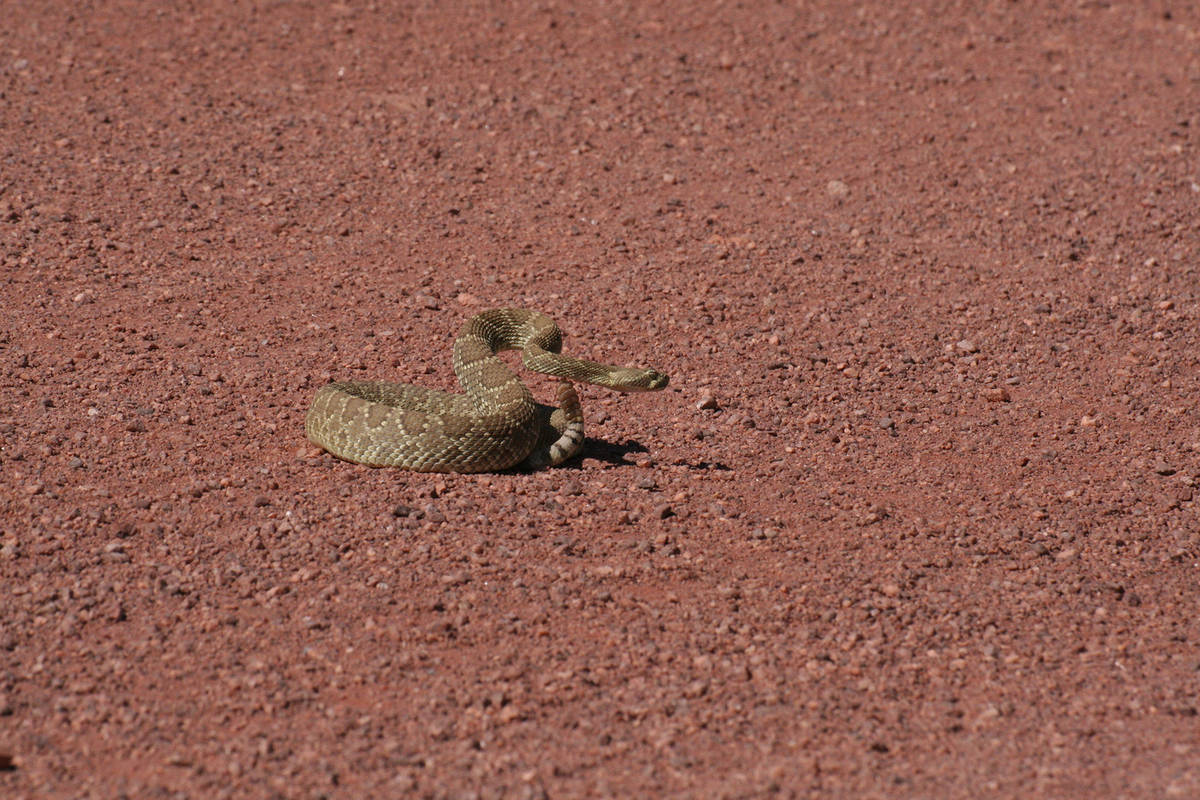
It’s that time of the year again when we want to be out exploring the desert in the perfect hiking temperature. But be warned: Snakes are out and about doing the same thing.
Sooner or later, if you’re an avid hiker or outdoors person in the Mojave Desert, you will come across a rattlesnake. This might be after a period of years or even the first time out. I’ve known outdoorsmen and avid hikers who grew up in our area, yet didn’t see their first rattlesnakes until they were in their 20s. On the other hand, my youngest daughter, now in her 20s, encountered her first one when she was about 5 or 6, and has come across dozens in her life. A few years ago, on the outskirts of Henderson, she came across five in just a matter of hours. It usually depends on the weather, the time of year and what terrain you are in.
Many of us know people who are so terrified of rattlesnakes they are repelled even by seeing them in a photograph. Others recognize them as beautiful creatures, at a safe distance. Whether you’re hoping to see one, or praying not to, it pays to know where they are most likely to be. Besides seeing them slithering around on the open ground, you might see them in dry washes, hiding in rock crevices and sunning themselves on rocks or boulders.
It’s extremely important that you always look before you put any part of your body anywhere. Surprising a rattlesnake is usually bad news. My oldest daughter, when she was about 12, was climbing up a boulder-covered hill of volcanic rock, seeking a good launching point for a jump into Lake Mojave. She startled a rattler that went for her face. She leaped back in fear, and luckily, her leap plunged her safely into the lake. Now in her 30s, to this day she can’t even look at a photo of a snake without shuddering.
Rattlesnakes enjoy temperatures from about 70-90 degrees, so spring and fall are the most common times to see them in our region. Yet in summer your worries aren’t over as they often hunt at night; being pit vipers, they can detect prey by its body heat. Along the edge of the Colorado River in summer I have seen many a western diamondback quickly retreat, under the canopy of a tamarisk, after hearing my footsteps.
It’s wise to learn the types of rattlesnakes in our area by sight, just in case you or someone with you gets bit. A doctor could help you much faster if they know what type of snake bit you.
In our area the ones you should know are the western diamondback, the sidewinder, the speckled and the Mojave. It’s easy to learn them through images off the internet or a field guide. They all have obvious color and pattern differences as well as average sizes.
The western diamondback rattlesnake is usually the easiest to identify. They have a diamond pattern, black circles around the tail and are often quite large, sometimes more than 6 feet long.
The speckled and sidewinder are the smallest. The former has bands around the body rather than a diamond pattern; the latter easily recognized by hornlike protrusions above it eyes and its curious sideward habit of crawling.
The Mojave is in between, resembling a diamondback but usually having a greenish tint to its body. The Mojave rattlesnake is one of the most venomous snakes in North America.
If you do come across any rattler be sure to walk a wide path around it or wait for it to slither away. Most rattlesnake bites are a result of interfering with one.
While people do occasionally die from rattlesnake bites, the majority of those bitten do not. Many bites are dry bites, meaning there was no venom injected. Sometimes only one fang will penetrate and the victim won’t get a full dose of poison. Most rattlesnake bites are on the leg or hand, which often gives victims time to seek medical help before the poison reaches vital organs.
Assuming you are out hiking and away from cell service to seek medical help, remember these cautions in case anyone of your party is bitten. The injured must not run to safety, or jump around in pain, as this can increase the circulation of blood and any venom it contains.
Apply a constriction band, such as an Ace bandage, between the wound and the heart to constrict the blood flow, but not as tight as a tourniquet. If possible, carry the injured person to a vehicle, or better yet, bring the vehicle to the injured. If alone, walk yourself out at an easy pace.
As quickly as feasible remove the shoe if the bite is on the leg, and rings, etc. if the bite is on the hand or arm. Get the person seated calmly in a position with the bite below the heart. Drive carefully toward civilization and call 911 as soon as you have cell service.
Do not cut the wound and attempt sucking out the venom, either by mouth in the Western-movie fashion or with the suction cups found in the old-fashioned snakebite kits. The best first aid is to get to a hospital.
Many of Deborah Wall’s columns have been compiled into books about hiking in the Southwest. She is also the author of “Great Hikes, a Cerca Country Guide” and a co-author of the book “Access For All, Seeing the Southwest With Limited Mobility.” Wall can be reached at Deborabus@aol.com.